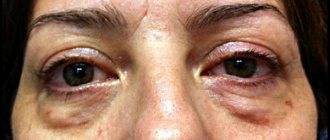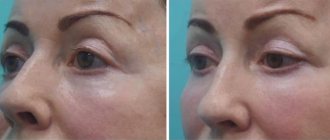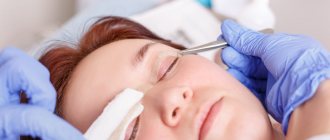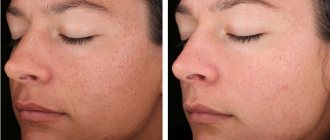Why do hernias appear under the eyes?
Hernias of the lower eyelid occur more often than those of the upper eyelid. The main reason is a more rapid weakening of the tone of the external muscles of the orbit. Stretching the tissue creates conditions for fatty deposits to accumulate and bulge through the resulting hole under the skin.
The process begins after the age of 30, when muscle fibers irreversibly lose collagen, which is responsible for elasticity.
The main factors contributing to the formation of fatty deposits are external and internal causes that impair the functioning of the eyes:
- various diseases with visual impairment near or far (defect in the function of the lens muscles);
- constant fatigue when working with a computer, in low light conditions;
- prolonged exposure to the sun or solarium (negative effects of ultraviolet rays).
Muscle atrophy develops under the influence of impaired general circulation against the background of heart and vascular diseases, anemia (anemia). Of great importance is the disruption of the nervous and endocrine regulation of vascular tone due to frequent stress, increased nervous stress, and lack of sleep.
Hereditary predisposition is caused by a reduced ability of the body to synthesize collagen and the occurrence of early deficiency. In obese people, lipid metabolism is disrupted, so excess accumulations of adipose tissue are deposited in the most exposed places.
Performing lymphatic drainage massage
If you, knowing what a hernia of the eyelid looks like, have discovered it in yourself, you can do a special massage yourself to help reduce the bulge in the eye area. The main condition is to perform massage manipulations according to the direction of blood flow. Massage algorithm:
- remove make-up, remove dirt from the face;
- gently apply cosmetic oil or nourishing cream to problem areas;
- use the pads of your fingers to lightly pat your face, choosing the direction from the temple to the inner corner of the visual organ;
- press the area of the lower eyelid for 2-3 seconds, and then carry out similar manipulations with the crease of the upper eye.
Next, perform 15 pressures on the outer and inner areas of the eyes. In between these light manipulations, press the center between the eyebrows, the area around the eyes, and then move on to the bridge of the nose. The massage ends with small tapping manipulations.
What do hernias look like?
A lower eyelid hernia looks like a subcutaneous sac. Some people mistake tissue swelling for hernias. It is difficult to distinguish by external manifestations. For swelling under the eyes, after measures to improve fluid outflow (massage, lymphatic drainage procedures), the “bag” disappears. But the accumulation of fat cannot be removed in this way. A true eyelid hernia promotes swelling because it compresses the lymphatic vessels.
Deposition of fatty tissue occurs in the inner corner of the eye or under the eyelashes. Depending on the location, a person is concerned about:
- lacrimation (the patency of the tear ducts is impaired);
- redness of the eyelids and rapid eye fatigue;
- feeling of pain.
The face looks swollen, tired, aged. In addition to bags under the eyes, dark circles form.
Possible complications
It must be remembered that, despite all its safety, blepharoplasty is a plastic surgery, not a cosmetic procedure, and it has a risk of complications. Postoperative complications are extremely rare, but when planning an operation it is worth considering all the risks in order to make the right decision. Sometimes it is preferable to refuse intervention than to regret what happened later.
The main postoperative complication is wound infection. However, if you follow all the doctor’s recommendations and properly treat the eyelid skin with antiseptics, the risk of infection entering the wound is significantly reduced.
The second serious complication is hemorrhage. It is especially dangerous if it occurs in the retrobulbar tissue (tissue located behind the eyeball). In this case, the pressure of the hematoma on the optic nerve can lead to dire consequences, including loss of vision. Therefore, it is so important to undergo all the necessary tests before surgery and not neglect the advice of doctors.
Another problem can be ptosis (drooping) of the lower eyelid. If the surgeon makes a slight miscalculation and removes a little more skin than he should, this could cause complications for the patient. The skin of the lower eyelid will tighten and it will fall lower than necessary. This situation can only be corrected with repeated plastic surgery.
As with any medical procedure, blepharoplasty may cause an allergic reaction to the drugs used. It can manifest itself in different ways: from a banal rash to anaphylactic shock. Therefore, it is very important to tell your doctor about any allergies or unusual reactions to medications.
In rare cases, lower eyelid blepharoplasty may be complicated by the formation of keloid scars.
Despite the long list of possible complications, there is no need to panic; they occur extremely rarely and are the exception rather than the rule.
How to get rid of an eye hernia forever?
Swelling of the eyelids caused by fluid stagnation can be removed using conservative methods, but only a surgical method can permanently destroy fat deposits in the periorbital area. Resorption cannot be achieved by other means. Any attempts to lose weight do not remove lipids from the resulting hernia. The purpose of effective treatment is suturing the separated muscles and mechanical removal of local excess adipose tissue.
As a conservative treatment that temporarily delays the divergence of the eyelid muscles and promotes lymphatic drainage, cosmetologists recommend hardware procedures:
- microcurrents - impulses increase the temperature in the affected area and activate collagen synthesis, 7 to 10 procedures are required with breaks of 2 days;
- radiofrequency thermolifting - activates metabolism in the eyelid area;
- ultrasound - distributes evenly penetrating fat, strengthens muscles, a single procedure is enough.
The following injection procedures are used:
- mesothreads in the paraorbital area - tighten the skin, fix the muscles;
- plasma lifting - up to 20 ml of blood is taken from the patient’s ulnar vein, filtered in a special apparatus and centrifuged, the purified plasma is poured into a syringe with a needle, which is used to prick the eyelids.
Surgical methods for removing a fatty hernia
Surgical intervention to remove a hernia under the eyes is included in lower eyelid surgery (blepharoplasty) and is performed in two approaches:
- through a skin incision on the outside along the eyelash line;
- an incision from the inner surface of the lower eyelid (transconjunctival).
The operation is simple and is performed under local anesthesia. Typically, excision of the excess skin flap and tightening are performed simultaneously. Sutures are placed on the muscle layer and on the skin. After removal 7–10 days later, the thin scar is almost invisible. During the rehabilitation period, the swelling gradually goes away, sometimes it is not possible to avoid the formation of a hematoma. The bruise goes away on its own within a week.
Laser removal of hernia under the eyes
The use of a laser beam to remove a lower eyelid hernia is associated with the ability to cut a minimal area of skin without a scalpel, remove fat cells, and “seal” the muscle hole. The process includes methods of influencing tissue using:
- coagulation - coagulation of protein molecules when heated, which is accompanied by dissection without bleeding;
- ablation - evaporation of excess fatty tissue, reducing the volume of deposits.
Laser exposure to the eye area requires caution. Choose the safest erbium and carbon dioxide devices. The procedure promotes overall rejuvenation of the skin in the affected area:
- swelling is eliminated;
- pigmentation disappears;
- the muscles of the eyelids are tightened.
The use of laser is contraindicated:
- for severe chronic diseases (especially diabetes);
- dry eyes;
- previous malignant tumors, the presence of a neoplasm regardless of stage;
- impaired blood clotting;
- during periods of acute infectious diseases, elevated temperature;
- mental illnesses (epilepsy).
It is not recommended to eliminate eyelid hernias during pregnancy and breastfeeding.
After operation:
After eyelid surgery, the patient does not require painkillers due to the absence of pain. Discharge from the clinic occurs in the evening, on the day of the operation.
After surgery, all patients experience swelling and intradermal hemorrhages of varying severity. The swelling decreases and goes away within a week after surgery. Intradermal hemorrhages resolve within 10-15 days. Until this time, it makes sense to wear dark glasses in crowded places. If intradermal sutures were placed during the operation, they are usually removed on the 5th day. The suture line (scar) becomes completely invisible after 1-1.5 months.
For a speedy recovery after blepharoplasty, a plastic surgeon may recommend courses of cosmetic procedures both before and after surgery. As well as placing eye ointments with antibiotics in the conjunctival sacs.
Folk remedies against fatty hernias
It is impossible to get rid of paraorbital hernias using traditional methods. Existing recommendations help provide skin care, improve microcirculation of the area, and fluid outflow. The visual positive effect is associated with a decrease in tissue swelling. Application will not lead to a guaranteed result, but will improve the condition of the skin. The most popular recommendations of traditional healers can be easily carried out at home.
Applying compresses with herbal remedies to the skin of the eyes:
- The avocado fruit is cut into thin rings, the juice should not get on the mucous membrane;
- Boil parsley decoction (2 tablespoons of chopped stems and leaves per glass of water) for up to 10 minutes, leave for another half hour, moisten gauze swabs or cotton balls and apply to eyelids;
- decoction of linden or chamomile flowers;
- mix equal parts rose oil and a warm solution of cosmetic clay;
- pulp of boiled pumpkin;
- decoction of birch leaves;
- grated raw potatoes.
Tea bags beloved by many do not have a healing effect. Treatment is carried out before bedtime, after washing. Keep the compresses for no longer than 20 minutes, then rinse with warm water. There is no exact definition of courses. Herbal remedies can be used throughout your life if they do not cause allergies.
Masks that reduce swelling of the eyelids
Masks require a stable base in the form of animal or vegetable fat. Folk recipes are offered for her:
- a mixture of camphor oil and lard (achieve complete mixing when heating);
- warm mashed potatoes with milk and butter;
- chilled fat sour cream;
- beaten egg white.
A few drops of herbal decoction are added to the base. The mask is applied to the skin around the eyes for 20 minutes. It is better to choose the evening time for treatment. 15–20 procedures are recommended per course.
After washing off the mask, it is useful to apply a nourishing cream and do a lymphatic drainage massage yourself. Using gentle movements of the fingertips, move several times along the lower eyelid, from the nose to the temples, then along the upper eyelid to the bridge of the nose.
What are the names of ointments for bags under the eyes?
In cosmetology, ointments are used to relieve puffiness under the eyes. Their main advantage is the content of substances that strengthen blood vessels and promote the removal of fluid into the lymph. Some remedies are known to have a simultaneous positive effect on varicose veins. The most popular drugs:
- "Heparin ointment";
- "Blepharogel";
- "Troxevasin";
- "Solcoseryl";
- "Curisiol";
- "Afulim";
- "Lyoton."
It is recommended to apply the ointment to cleansed eyelid skin 3 times a week and rinse off with warm water after 20 minutes. Be careful not to get the product into the eyes.
Remove bags under eyes with exercises
Gymnastics for the eyes is included in the face-building complex. Recommended for improving blood supply to the periorbital area and eyelid skin. The result is activation of fluid removal and improvement of microcirculation. To eliminate bags caused by edema, you need to spend 5-7 minutes 2-3 times a day. Start the number of repetitions from 10 and increase to 20. List of useful exercises:
- open (goggle) your eyes as much as possible, hold the state for 10 seconds, then close your eyes tightly for the same period;
- “clap” your eyelashes 10 times, then squeeze your eyelids tightly;
- move your gaze from the uppermost point (try to go under the eyelid) to the lower one;
- make circular movements of the eyeball in one direction, then in the other.
At the end of the gymnastics, it is useful to relax your eyes closed and apply a mask.
Hernia of the eyelids: causes
The skin of the eyelids is practically devoid of subcutaneous tissue and is therefore prone to stretching. The orbicularis oculi muscle and the skin of the eyelids weaken early and lose their elasticity, mainly due to repeated contractions during blinking.
The main reasons for the formation of an eyelid hernia are age-related changes, heredity and constitutional features. The formation of hernias is also accelerated by stress, lack of sleep, hormonal changes, constant eye fatigue, ultraviolet radiation, smoking and alcohol consumption.
What to do to avoid hernias?
To prevent the formation of fatty hernias in the eyelid area, you will have to accustom yourself to seriously engage in cosmetic procedures from the age of 25–30. At a young age, masks made from herbal remedies are suitable; after 40, nourishing creams and special ointments are needed to activate microcirculation and fluid outflow. You cannot use heavy cosmetic preparations with hormones on your own.
Recommendations for protecting your eyesight are important: breaks after every 40 minutes of working on the computer, sufficient illumination of the workplace, wearing dark glasses when going out into the bright sun, eye exercises.
A healthy lifestyle without bad habits, with a balanced diet, sufficient fluid intake, alternating work and rest helps to maintain the tone of the eye muscle frame and normal fat metabolism longer.
Preparation for lower eyelid blepharoplasty
No special complex preparation is required for this intervention. However, in order to exclude undesirable consequences (exacerbation of chronic diseases, bleeding), the following examinations should be performed before the operation:
- ECG;
- fluorography;
- general and biochemical blood tests (including leukocyte count and platelets);
- general urine test (to check stable kidney function);
- coagulogram;
- blood group test, Rh factor (required for emergency intervention in unforeseen circumstances);
- analysis for HIV infection, markers of viral hepatitis and syphilis.
Before surgery, it is recommended to stop taking medications that affect the ability of blood to clot (aspirin, heparin), and give up bad habits (smoking).
Advantages of laser blepharoplasty:
- A combination of patented laser techniques in one procedure.
- Local anesthesia.
- Minimum rehabilitation period (1-3 days)
- No seasonal restrictions
- Unsurpassed effect of anti-aging therapy in the middle third of the face.
- Safety (protective eye shields are used).
The results of laser blepharoplasty are comparable to the effect of plastic surgery. But the procedure has no side effects and does not require long-term rehabilitation.
2.Injection blepharoplasty. It involves injection into the area above or below the eyelid of a special agent that resolves fat deposits, removes excess fluid and activates the regenerative properties of the skin. Injection blepharoplasty is performed on both the lower and upper eyelids. The injected drugs help eliminate wrinkles, launch natural regeneration processes, and eliminate excess subcutaneous fat.
The result is to “open” the eyes, smooth out the skin texture, and achieve an aesthetic appearance. As a result, throughout the entire duration of the drug’s action, wrinkles are smoothed out, swelling, dark circles and bags under the eyes go away, and hernias are smoothed out.
To perform contour injection blepharoplasty, fillers based on hyaluronic acid are used, which, evenly distributed, smoothes the skin surface and triggers rejuvenation processes by stimulating the production of collagen and elastin.
The tissues are saturated with moisture and the production of elastin and collagen is stimulated. In addition to hyaluronic acid, bioremediation mesococktails are used to achieve similar goals.
Among the substances in this group are:
- Yuvederm;
- style;
- Glytone;
- Teosyal;
- Dermaheal eyebag solutions;
- Meso Wharton P199;
- Meso Xanthin F199.
Another group of drugs is aimed at combating excess tissue that contributes to excessive drooping of the eyelids, the formation of bags, edema, and hernias. Problems are solved using lipolysis. They use drugs based on natural ingredients that trigger the process of breaking down adipose tissue and normalizing metabolic processes. Among the drugs in this group, the following are popular:
- Lipostabil;
- MRKh complex;
- Caregen;
- Aminomix.
Important! The choice of the drug is made by a cosmetologist. A professional assessment of external signs helps to correctly determine the means of control.
3. Microcurrents. Microcurrent therapy is a soft and delicate hardware technique for facial rejuvenation. During this procedure, a pulsed current of low voltage and with different frequency characteristics affects the skin, muscle tissue, lymphatic and blood vessels. Microcurrents help increase energy reserves in cells, change the resting potential on membranes, normalize metabolic processes, and have a lymphatic drainage, anti-inflammatory and regenerating effect.
- Effects of microcurrent therapy.
- improvement of skin microcirculation, which ensures sufficient delivery of nutrients and oxygen to cells and timely removal of toxins;
- increasing the firmness and elasticity of the skin, tightening the skin due to the activation of fibroblasts;
- elimination of bags under the eyes and dark circles under the eyes;
- normalization of trophism and skin moisture;
- optimization of the sebaceous glands, narrowing of pores, getting rid of acne on the face;
- stimulation of local and humoral immunity to prevent and eliminate inflammatory processes on the skin;
- normalization of melanocytes (cells that produce pigment) and acceleration of melanin breakdown, which helps improve complexion and reduce signs of skin photoaging;
- normalization of muscle tone;
- elimination of facial swelling;
This leads to remodeling and activation of collagen and elastin synthesis, which helps tighten and tighten the skin, restoring firmness and elasticity of the skin. Due to the lifting effect, the skin of the upper eyelid is tightened and ptosis is reduced. The procedure prevents an increase in the amount of fat under the eyelids, normalizes microcirculation and lymph flow.
Still have questions? Call!
Sign up for a free consultation with a cosmetologist with digital skin diagnostics. With its help, you can accurately determine the condition of your skin and identify existing problems.
Our specialists will conduct a detailed analysis of the data obtained and select the most suitable technique for you, taking into account individual characteristics and financial capabilities, or develop a personal program of procedures.
The integrated use of various types of rejuvenation allows you to preserve the effect of the procedures for a long time and achieve results such as a toned and elastic face shape, young and healthy skin. This means delaying the manifestation of age-related changes for several years!
Our doctors have extensive experience and a light hand! Attention, care and comfort during the procedure are guaranteed!











